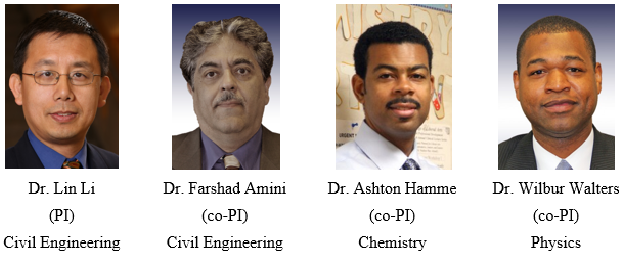The National Science Foundation has awarded Department of Civil and Environmental Engineering a $559,660 Major Research Instrumentation (MRI) grant. The PI is Dr. Lin Li, Department of Civil & Environmental Engineering, and Co-PIs are Dr. Farshad Amini, Chair, Department of Civil & Environmental Engineering, Dr. Ashton Hamme, Department of Chemistry & Biochemistry, and Dr. Wilbur Walters, Department of Physics, Atmospheric Sciences & Geoscience. The grant, “MRI: Acquisition of a Multi-Bean SEM/FIB for Multidisciplinary Materials Study and Training”, is to support the acquisition of an advanced scanning electron microscope coupled with focused ion beam capable of milling depth up to 100 micro meter at image resolutions of 2.5 nanometer. The SEM/FIB can be used to analyze three-dimensional (3D) structural characterization and compositional information for the composite materials. The focused ion beam uses the milling function to create continuously cross section inside the composite materials that can be observed with SEM at nano-scale resolution and forms a 3D structural characterization of the composite materials.
These advances have made SEM/FIB a unique tool for researchers in engineering, chemistry, physics, biology, and material disciplines to conduct cutting-edge material-related researches, including bio-mediated soil materials, stratified contractive undrained silt-sand-gravel composites, nanoparticles for biosensing, engineered nanomaterials, grapheme-cement nanocomposites, and polymer-clay bio-inspired nanocomposites. The built in energy dispersive X-ray analyzer in the SEM/FIB can provide the elemental analysis and chemical characterization of these materials. The high-resolution of SEM images along with the FIB trimming path will illustrate the internal structure of the materials at the nano-scale. The patterning of complex nanostructures and simultaneous detection of topographical and compositional information will lead to a better understanding of the structure-property relationship and engineering applications of these composite materials.
The implementation of this project will enhance instrumentation infrastructure at Jackson State University with significant Ph.D. programs, committed to high quality research and advanced graduate studies. The instrument promotes partnerships and collaborative activities among researchers in surrounding universities and national engineering research centers, including University of Mississippi, and U.S. Army Engineer Research & Development Center. The instrument will be housed in the Nano Laboratory at the Engineering Building, Jackson State University.

